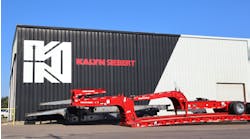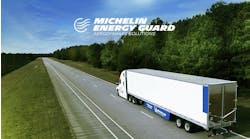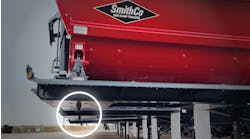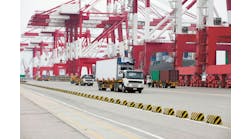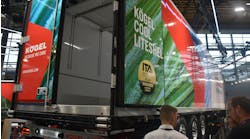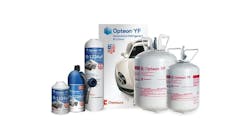ZF’s no-touch supply chain: From the factory floor to the DC to the Last Mile, sensors and algorithms are taking over logistics
Friedrichshafen, Germany. At global automotive supplier ZF Friedrichshafen AG, “See-Think-Act” isn’t just a corporate marketing slogan, it’s the basic blueprint for product development. The company recently hosted ZF Technology Day—a biennial media event to preview the wares on display at next month’s IAA Commercial Vehicles show in Hannover—to demonstrate the scope of its R&D prowess, organized around the theme “Smart Logistics.”
With sales of more than $40 billion in driveline, chassis, and safety technology last year, the chances are good these ZF innovations will become the building blocks for the next-generation of electrified and automated offerings from the world’s passenger car and commercial vehicle OEMs.
For anyone in the transportation equipment business, it’s a look at future products. And for some, especially large manufacturers, it’s a look at future production processes as well.
The big picture
In his introductory remarks, ZF CEO Wolf-Henning Scheider outlined the current challenges and opportunities in transportation, and the company’s coming solutions.
Despite popular press accounts and public enthusiasm, Scheider—like many of those responsible for actually developing the technology—contends that automated driving systems will see “wide use” in commercial vehicles “much earlier” than in passenger cars.
“We believe autonomous technologies will become standard in areas where they increase operational security and reduce operational costs,” he said. “Here the fruits are hanging lower because of the immediate total cost of ownership benefit and less complexity.”
Such technology will be deployed first in “clearly defined fields of application” such as mining, farming, and freight yards—where the advantages will be seen “very soon.”
Indeed, with a couple of innovative solutions demonstrated in action around its own facilities, ZF shows what direction logistics could take at intermodal hubs and distribution centers.
Specifically, the vehicles could autonomously maneuver swap bodies or trailers to their respective destinations. This enables the logistics sector to improve efficiency while reducing accidents and avoiding damage; and driverless vehicles help counter the ever-growing shortage of skilled workers.
The ZF Innovation Truck and the Terminal Yard Tractor offer just such future-oriented solutions to the central challenges faced by fright handlers.
“Autonomous vehicles that, thanks to our technologies, can see, think and act are turning the idea of consistent smart logistics into reality, at depots and other specified areas,” said Fredrik Staedtler, head of ZF’s Commercial Vehicle Technology Division. “These vehicles can prevent maneuvering damage and downtimes, which gives logistics companies a competitive advantage. The functions presented in our current innovation vehicles are therefore applications that are in high demand and pay off quickly.”
When maneuvering in the depot, challenging tasks such as lifting, shifting and stacking containers—meaning unloading freight from one truck and loading another—are the ones that tie up driver resources the most, cost time, and often lead to accidents and expensive damage.
In contrast, the ZF Innovation Truck—a hybrid truck based on a heavy six-wheeler—carries out these tasks without a driver. As demonstrated, as soon as the driver has entered the premises, he can get out, activate the autonomous driving mode and then take a break. The truck will find its way to the target position driving autonomously and electrically.
Likewise, without a driver, the ZF Innovation Truck then loads a new container. Controlled by the central computer ZF “proAI,” the ZF Innovation Truck manages this quickly, precisely, and with the maximum possible safety. In addition, neither stress, fatigue, distractions nor darkness or adverse weather conditions can influence the truck.
While ZF proAI is the Innovation Truck’s brain, other ZF technologies enable it to act: among others, the active electrohydraulic ReAX commercial vehicle steering system and the TraXon Hybrid automatic transmission system. The latter features a modular integrated electric motor that allows locally emission-free driving. To give the ZF Innovation Truck its orientation and vision, the company selected a cost-effective, camera-based and laser-supported sensor setup, completing it with a GPS system.
The extended sensor set additionally enables the Terminal Yard Tractor to keep an eye on its surroundings. This enables this shuttle vehicle to take the trailer from the truck and autonomously maneuver it to the ramp for loading and discharging. Once this has been completed, it takes the trailer back to the truck.
An intelligent and dynamic routing system tells each innovation vehicle where to go, when to go, and what to do there. The routing constantly checks and considers, for example, the vehicle’s current position and the routes of other vehicles on the premises and immediately adjusts the vehicle’s own routing when necessary.
Thanks to a sensor set in the vehicle and a routing system on the work premises, drivers are shown on their tablets how to approach and pick up the respective swap bodies quickly and smoothly.
In the factory
Since August 2017, ZF has been retrofitting a section of Plant 2 at its Friedrichshafen location with intelligent systems in order to streamline delivery logistics and internal production material flows. This project has been dubbed the ZF Model Factory.
ZF hopes to simultaneously satisfy two of its technology challenges: First, by developing and marketing practical solutions for intelligent transport systems, such as trucks and yard tractors. Second, by contributing to other autonomous driving development activities.
Modern industrial production is all about the turnover of goods. About 70% of the movement of goods during the production process consists of materials transport before the materials can be further processed by machines or other assembly equipment as part of the value-added chain, according to ZF. Manufacturers who organize the delivery and transport of components to workstations see substantial improvements in productivity with this connection.
“We want to combine the various areas of expertise in the ZF Group, including electromobility and autonomous driving, as well as commercial vehicle and industrial technology,” Ilker Sari, head of the factory, said. “Our pilot projects are like display windows of the future.”
In addition to optimizing internal production processes and interconnecting Industry 4.0 and smart logistics approaches, the company uses the pilots as support in targeting the commercial vehicle and industrial technology markets.
“Autonomous driving has strong potential—not only on public roads but also within private compounds,” added Sari. “We want to leverage the benefits gained from developing autonomous driving functions within the commercial vehicle and industrial technology markets, showing that we are a leader in these sectors.”
This is not just about conventional driverless transport systems, as they have been used successfully in factories for decades; those vehicles are operated primarily on defined and partially blocked-off routes to perform simple transport activities.
“For us, it’s about vehicles that interact with their environment, using smart sensors and an intelligent control system linked to the inventory management system. These vehicles are flexible and can adapt to actual demand,” said Sari.
The autonomous transport systems in the ZF Model Factory can master a multitude of new functions: They can overtake, avoid obstacles and search for alternative routes when roads are blocked. Thanks to intelligent control systems and interconnected guidance systems, material transport can be prioritized and controlled, improving lead times, increasing availability and, therefore, improving buffering in production.
Of course, in many production arenas the trick is to have the incoming material arrive at the same time as the person—or autonomous vehicle—responsible for receiving it. Currently, waiting times at the gate and incoming goods area are normal and transport papers must be entered manually into the materials management system.
The ZF Model Factory team is working together with supply chain experts on a tracking system that keeps ZF, as the goods recipient, informed of the location of the delivery truck at all times and can predict its arrival time down to the minute. It also records whether the driver has to maintain break times after delivering the goods. Unloading times are therefore scheduled to coordinate with the driver’s break times.
The trailer also can be disconnected prior to entering the company’s grounds and be moved to the incoming goods area by autonomous transport systems. BLE tags (active RFID) record digital data about possible shocks or other events during the freight transport. This data as well as information from the shipping documents can be transmitted digitally to the materials management system.
As soon as the delivery truck approaches the company’s premises, the necessary forklift trucks are assigned to the unloading area—reducing truck idle and unloading times, and eliminate long wait times at the gate.
The same coordination of material flow continues to the production floor. Every day, several hundred assembled ZF commercial vehicle transmissions leave Plant 2 in Friedrichshafen. These transmissions consist of up to 1,000 individual components. With over 100 large shipments per hour, the logistics process comes together in the final assembly area.
For ZF, as for any manufacturer, coordinating the logistics for the assembly processes is critical. At the ZF Model Factory the delivery of material to the assembly stations, including preparation, is being done autonomously.
The starting points are today’s “milk-run trains,” or shared-route cart systems, that bring the goods to assembly in the precise production sequence (“just-in-sequence”). Material distribution and milk-run trains are controlled manually. The ZF Model Factory has completely done away with these. Instead, autonomous transport systems directly supply the containers storing the pre-assembled parts to the assembly area. With this approach, logistics processes can be better and more precisely controlled.
In order to optimize the set-up of these processes, the material flow logistics planners from the ZF plant are directly involved in the Model Factory. Additional initial use cases will be implemented throughout the year and then continuously developed. In the meantime, ZF customers in passenger car and commercial vehicle sectors will also benefit: Experience from the model factory is directly incorporated into advanced engineering for autonomous driving functions.
Final Mile
Increasingly, consumers prefer to determine when and where they receive their parcels. The electrically driven Innovation Van utilizes ZF’s expertise in automated driving to the requirements of the logistics sector—using a smart algorithm that takes into account customer requests in real time and calculating the most efficient delivery route.
A mammoth task for delivery services: A daily ratio of 200 parcels is nothing unusual for couriers. On average, they have two and a half to three minutes to make each delivery. This includes time for parking the vehicle, walking to the front door and waiting for the door to be answered before physically delivering the parcel—every additional action counts.
In 2016, ZF’s future study had already identified the issue of last mile logistics and took a closer look at the challenges couriers face during the last mile to the customer. The Group is now unveiling a concept vehicle for logistics service providers.
“Our Innovation Van is an extensive solution tailored to the requirements of the delivery sector,” said Gerhardt Gumpoltsberger, head of Innovation Management at ZF. “In order to meet the wide range of challenges of inner-city deliveries, we called upon our entire range of competencies—from autonomous driving and electromobility right up to networking within a smart support system.”
The Innovation Van is equipped with level 4 autonomous driving
functions. The delivery truck is designed to independently maneuver through urban surroundings, stay on course even if roads do not have lane markings, recognize both traffic lights and road signs and react to sudden hazardous situations. In addition, it can recognize and avoid obstacles such as vehicles double parked.
The tablet-based remote control is particularly helpful for a courier: If two addresses are so close that the best delivery route is on foot, the Innovation Van follows the courier as if on a virtual leash. If there is no parking available outside an address, the courier can send the vehicle ahead to the next stop, where it will look for a parking space on its own.
The entire ZF sensor set, consisting of camera, radar and lidar sensors, helps to ensure that the delivery truck is completely aware of its surroundings at all times. The ZF proAI central computer is capable of assuming control, processing the data generated by the sensors and enabling the vehicle to react appropriately to complex situations.
In addition, intelligent mechatronic systems, such as the electric power steering and the integrated brake control (IBC) can reliably carry out the central computer’s instructions. The electric axle drive system for passenger cars and light commercial vehicles is responsible for the purely electric and locally emission-free drive.
To be able to find the most efficient delivery route at any time, the Innovation Van accesses a cloud-based support system. Data for each package on board the vehicle is stored, such as destination and preferred time of delivery, along with other information, such as the shelf life of perishable goods.
“The algorithm takes this information, adds parameters such as traffic conditions or energy consumption and calculates the ideal delivery sequence in real time,” explained project manager Georg Mihatsch. “Basically, the parcel itself finds the best way to get to the customer—and the vehicle follows.”
The parcel courier receives this information via mixed reality smartglasses. This allows them to review all relevant data.
The consumer also benefits from the support system in the cloud: The app not only enables them to track the parcel’s route, but also to change delivery data at short notice. This allows consumers to easily redirect parcels to a particular neighbor at any time, or to push delivery time back if they are delayed by something unexpected. This benefit is also of value to the courier: Instead of waiting in vain for the doorbell to be answered and possibly having to come back the next day, the courier can move on to the next delivery.
Too much, too soon?
While the ZF Technology Day demonstrated that these automated systems are certainly within reach, significant barriers—both in terms of public and regulatory acceptance, to say nothing of a demonstrated business case—are a counterweight to the sometimes unrealistic expectations of supporters.
How does ZF weight the opportunities and risks?
CEO Scheider points to the partnership with German startup e.GO to build a Level 4 people mover, a driverless bus concept (also on hand for the demo day) that will incorporate ride-sharing technology as well.
“This partnership is thrilling, because we are challenging ourselves. We have a great opportunity to learn—it give us a development environment that’s very unique,” Scheider said—but he also noted that ZF, as a closely held corporation, has the freedom to explore while also investing in improving existing technologies. “We have an ownership that doesn’t require us to build our strategy based on [investment] analysts’ opinions, but only on our business model. And that is next-generation mobility.
“On the other hand, we still see a lot of potential in products that are evolutionary, such as our transmissions. We have an advantage to be free in our decisions to just do the things we consider right.”
